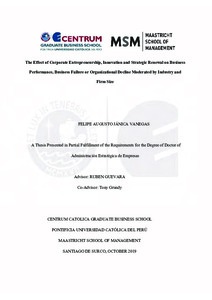El sistema se apagará debido a tareas habituales de mantenimiento. Por favor, guarde su trabajo y desconéctese.
The effect of corporate entrepreneurship, innovation and strategic renewal on business performance, business failure or organizational decline moderated by industry and firm size
Abstract
The largest and most successful companies in the world have not always been that way. The challenges they have faced in order to become what they are today may have been countless. In contrast, while many companies have achieved significant levels of growth, they have not all been able to maintain their success in the long term, even to the point of starting to fail. This Thesis provides a conceptual framework that tends to explain the effect of CE that encompass I and SR on BP in Colombian companies, so the lack of CE, I and SR moderated by size of and sector/industry, might lead the Colombian companies to BF or OD. The research was developed using the information provided by regulatory entities in Colombia. The information gathered included both financial and managerial information submitted to the Colombian Superintendency of Corporations by companies that have entered into the restructuring process during the last ten years, as supervised by the Colombian Superintendency of Corporations and based on the Colombian Law on Restructuring during the last decade. Out of the 131 companies included in this research, 53 (40 %) belonged to the manufacturing sector and 78 (60%) belonged to the service sector. Regarding company size, 60 (45,80%) were small, 27 (20,61%) were medium and 44 (33,59%) were big. The information gathered included both financial and managerial information submitted to the Colombian Superintendency of Corporations by the companies that have entered into the restructuring process during the last ten years, as supervised by the Colombian Superintendency of Corporations and based on the Colombian Law on Restructuring during the last decade. For this purpose, this study used the data base information provided by the Colombian Superintendency of Corporations. This research excluded information obtained from agencies other than the Colombian Superintendence of Corporations. This research did begin with a pilot study developed with a case study that took into consideration a survey and interviews with representatives of companies that have entered into a restructuring process. The Superintendency’s website provided the list of the companies in the restructuring process. This information includes the approved financial services companies and detailed information on the legal representation of those companies. A two-stage sampling process was followed in identifying the subjects for the sampling. In stage one, this research used a probability sampling that is based on stratified random sampling. In order to determine the size of the sampling, the following formula was taken into consideration: n=(N*Z2a*p*q)/((e2*(N-1)+(Z2a*p*q)), where n is the size of the sample, N the size of the universe, Z the level of confidence, e the margin of error p and q the probability of occurrence. A level of confidence of 80% and error margin of 5% was determined by the researcher. In stage 2, the selection of participants from the organizations represented in the now-established sampling frame will be selected in terms of the criteria that the selected participant be registered in the restructuration process data base provided by the Superintendency of Corporations. A single contact person will be identified within each organization, with this person furnishing the contact information of employees who, meeting qualifying selection criteria, will be selected to be the research participants. The identified participants will then be called on their telephones, and a follow up e-mail will detail the research objectives). The participants will be considered “front facing” – in other words, they are part of, or were part of the decision-making process in their companies.
For the quantitative part, the paths of the hypotheses among the main latent constructs will be then assessed using a structural equation modeling (SEM) procedure. For the quantitative part the research will use Atlas TI. As with standard regression, the basic measure of association between variables is covariance, and the dynamics of actually fitting SEM models involve covariance structure modeling (Iacobucci, 2009).
The model shows that CE has a direct influence on BP. It is important to highlight that CE is influenced only by I. SR does not have a direct impact in CE. It could be inferred that the Colombian companies do not perceive that CE is a crucial part of the strategic planning. Furthermore, CE does not impact OD. It can be inferred that the more CE activities the Colombian companies put in place the better the outcomes from the business and financial performance. Thus, the Colombian companies that are facing OD could have avoided it by implementing CE activities.
Temas
Cambio organizacional
Emprendimiento
Emprendimiento
Para optar el título de
Doctor en Administración Estratégica de Empresas
Collections
The following license files are associated with this item:






